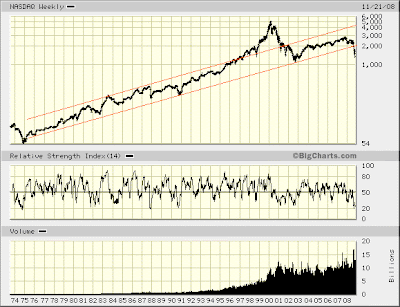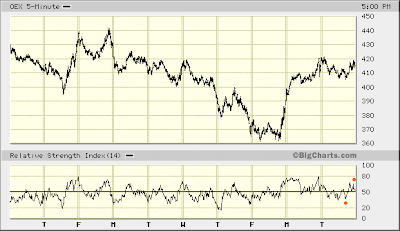A bullish outlook toward the stock market by no means requires one believe all is well. Indeed, I may be "the Chip Diller of Stock Market Analysts," but I also am a realist. I appreciate the many reasons for hysteria common among bears. Truly, I do.
Nevertheless, successful investing sometimes requires one be an opportunist even when the fundamental background appears dire.Take, for example, the fact the
Great Depression extended throughout the entire decade of the 1930s. Economic and financial circumstances were extraordinarily strained, and by no means resembled conditions prevailing during the Roaring '20s. Difficulties persisted ... unemployment remained high ... life was no bowl of cherries for most Americans ... the prospect hard times might never end dominated public opinion.
Yet despite all this, the stock market, after having bottomed in 1932, more than doubled by 1940.

So, starting with this background let's consider the possibility the present moment bears some compelling similarity to the stock market's bottom in 1932...
Let me be clear. I certainly am not suggesting there is a high probability the stock market will rise for decades to come, much as occurred post-1932. Nor do I suppose the market's pending bottom will even hold up. Indeed, today's lows could be exceeded sometime over the next few years. I continue to believe the Dow Jones Industrials Average
could fall to the vicinity of 3600, as the market "corrects" its advance from
1974-2007.
With this in mind, then, let's consider why the market bottomed in 1932, and do so by making just one reference to factual reality at that time in history. Truth is the banking system did not go into a death spiral until
after the stock market bottomed. So, what made the market rise?
Well, I couldn't tell you. All I can see is it clearly did.
One thing is certain, too. Sellers no longer overwhelmed buyers. Likewise, buying interest came from players whose pockets were deep enough to create an environment conducive to a rising bid.
So, deciphering various technical formulations I have found useful for nearly 25 years I can develop an objective basis for strongly suspecting similar circumstances leading to the 1932 bottom and subsequent advance likewise might be present here.Bottom line... the current environment probably represents a low-risk opportunity to get long the stock market in your 401(k).Even if your 401(k) has been safely sheltered in a money-market fund (per my
May 10, 2008 alert), you might want to consider wading back into stocks. This alters my
October 18, 2008 view, when I was relatively more ambivalent toward the stock market's intermediate-term prospects. I simply thought any pending rally — likely to be the strongest advance in five years — might be too fleeting to think about risking your 401(k) capital. That's why I said, "[If] your 401(k) presently is safely sheltered in a money-market fund, you really don't need to change a thing."
However, truth is I simply cannot ignore the likelihood a low-risk opportunity exists here. A sustained rally lasting some months, indeed, appears rather probable.
Right now it appears you have some time to position your 401(k) in the stock market. The ongoing bottoming process seems likely to continue over coming weeks. Yet once bottom is in an explosive rally could ensue, and carry indexes strongly higher with scarcely a pause. So, just be aware of that, too.
If you are unsure about what to do, then get my recommended strategy for smartly positioning your 401(k) in select stock market investment alternatives your plan offers.Send an e-mail to:
Subject: 401(k) STRATEGY
When it comes to your retirement ... time truly is of the essence. That's why
low-risk opportunities to score fat, double-digit percentage gains investing in the stock market simply should not be passed up. This is particularly true when a projected advance is slated to last many months, and possibly some years. Such an occasion, indeed, appears at hand...

This is the arithmetically-scaled chart of the NYSE Composite I presented in
20/20 Hindsight Meets $20 Million Foresight. I wanted to magnify the area of price support this Elliott Wave Guy finds in "the fourth wave of one lesser degree" (which in this case is wave
(4) of
⓷ from 1987-1994).
I see strength here. Weekly RSI is
diverging (from its October '08 reading) as the Composite has fallen to a new low for the year ... which, coincidentally, is at the bottom of its [ascending] range (extending the 1987-1994 period forward) ... and which intersects the area where the market found legs back in '02 - '03 ... having declined on relatively tame volume (not at all revealing any sort of panic-stricken, dumping of shares onto the market) ... which, itself, means the "vested interest" has not thrown in the towel and given up hope. All these substantiate my view that, a
technically positive condition exists here.
So, if you ever were looking for a low-risk entry point into the stock market, this is it.The reason why is because you have strong basis for cutting your losses if these presumably positive technical indications fail. Are you following? Going long the stock market here is low-risk because you have an opportunity to objectively set tight stop-losses.

As you can see, another line of support — the NYSE Composite's rising trend line since 1974 (the blue line) — has been reached. So, that's another positive.
What I wanted to show here, though, is upside potential. Do you see the [gray] rising channel from 1982-2000? This channel contains wave
⓷ of
V.
(Wave
V began in 1974, and is the fifth wave of five waves from 1932.)
When the bottom end of this channel gave way in 2002, the support it once provided subsequently became resistance. You see how the NYSE Composite bumped up against this resistance 2004-2007. Although the index persistently rose once it bottomed in '02 - '03, it never really decisively penetrated this [rising] line of resistance.
Fast forward to the present...
The [red] rising channel from 1974-2007 contains all five waves of wave
V. As you can see, support at the lower end of this channel gave way during the market's September - October collapse.
So, could we see this former line of support act as resistance over months and years ahead?
Seems reasonable. Now, look at the percentage gain an advance back up to this area of resistance represents. Nice. Your 401(k) would stand to be rather positively affected...

I wanted to give you a picture of how things are shaping up on NASDAQ. The lines drawn above are entirely arbitrary compared to those defining NYSE Composite Elliott wave channels I just presented. Still, you see how areas of "support" and "resistance" appear to have developed...

The NASDAQ Composite's five-wave channel from 1974, I believe, ended in 1997. Since then (believe it or not) the NASDAQ Composite has been in "corrective" mode. Part I unfolded from 1997-2002. Part II presently is forming.
Elliott Wave-related considerations have me supposing the NASDAQ Composite could rise above its peak in 2007. Here, I suspect the lower end of NASDAQ's channel — formerly a line of support — may not act as resistance.
Or ... maybe it will ... thus, giving rise to the possibility the market might remain rather buoyant for at least the next couple years.
Get my recommended strategy for smartly positioning your 401(k) in select stock market investment alternatives your 401(k) plan offers.Send an e-mail to:
Subject: 401(k) STRATEGY
* * * * *
© The Risk Averse Alert — Advocating a patient, disciplined approach to stock market investing. Overriding objective is limiting financial risk. Minimizing investment capital loss is a priority.
Analysis centers on the stock market's path of least resistance. Long-term, this drives a simple strategy for safely investing a 401(k) for maximum profit. Intermediate-term, investing with stock index tracking-ETFs (both their long and short varieties) is advanced. Short-term, stock index options occasionally offer extraordinary profit opportunities when the stock market is moving along its projected path.
Nothing is set in stone. Nor is the stock market's path of least resistance always known. More often than not, there are no stock index option positions recommended. There's an easy way to boost your investment discipline...
There's an easy way to boost your investment discipline...
Get Real-Time Trade Notification!



 There's an easy way to boost your investment discipline...
There's an easy way to boost your investment discipline...












































